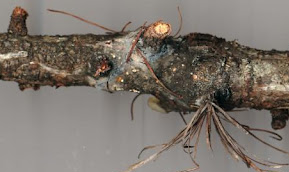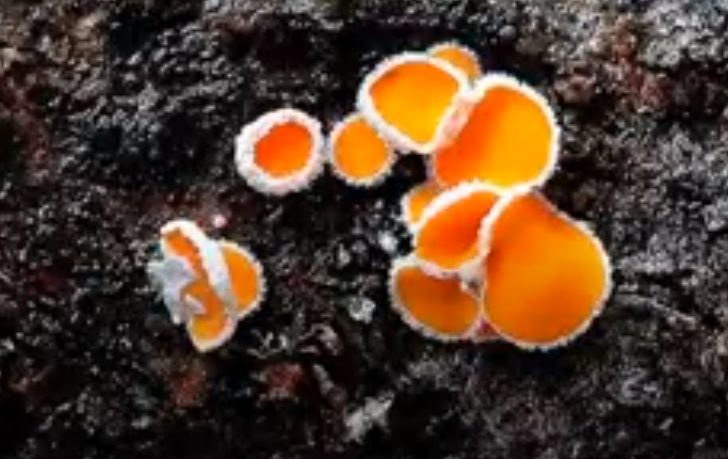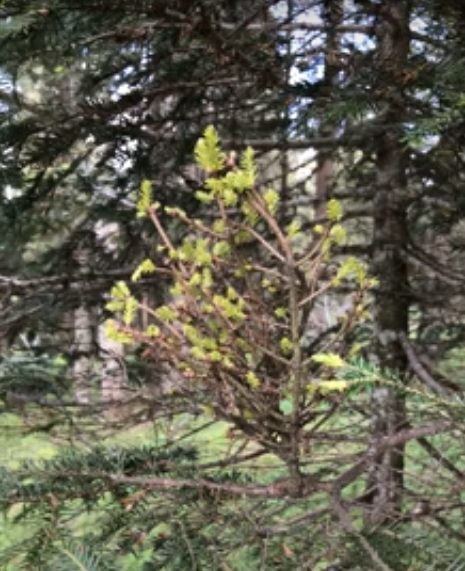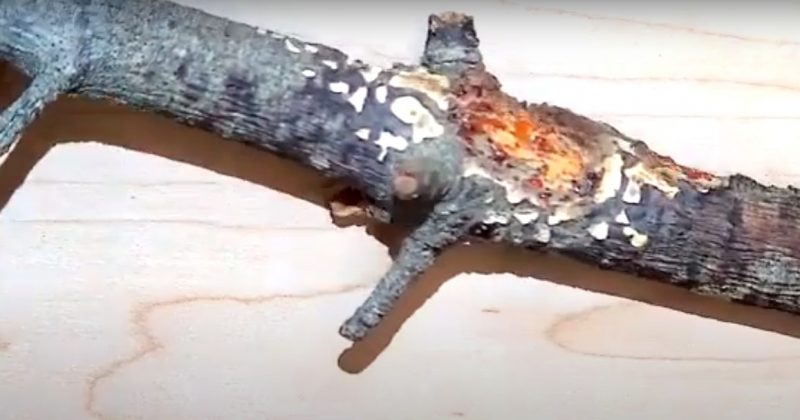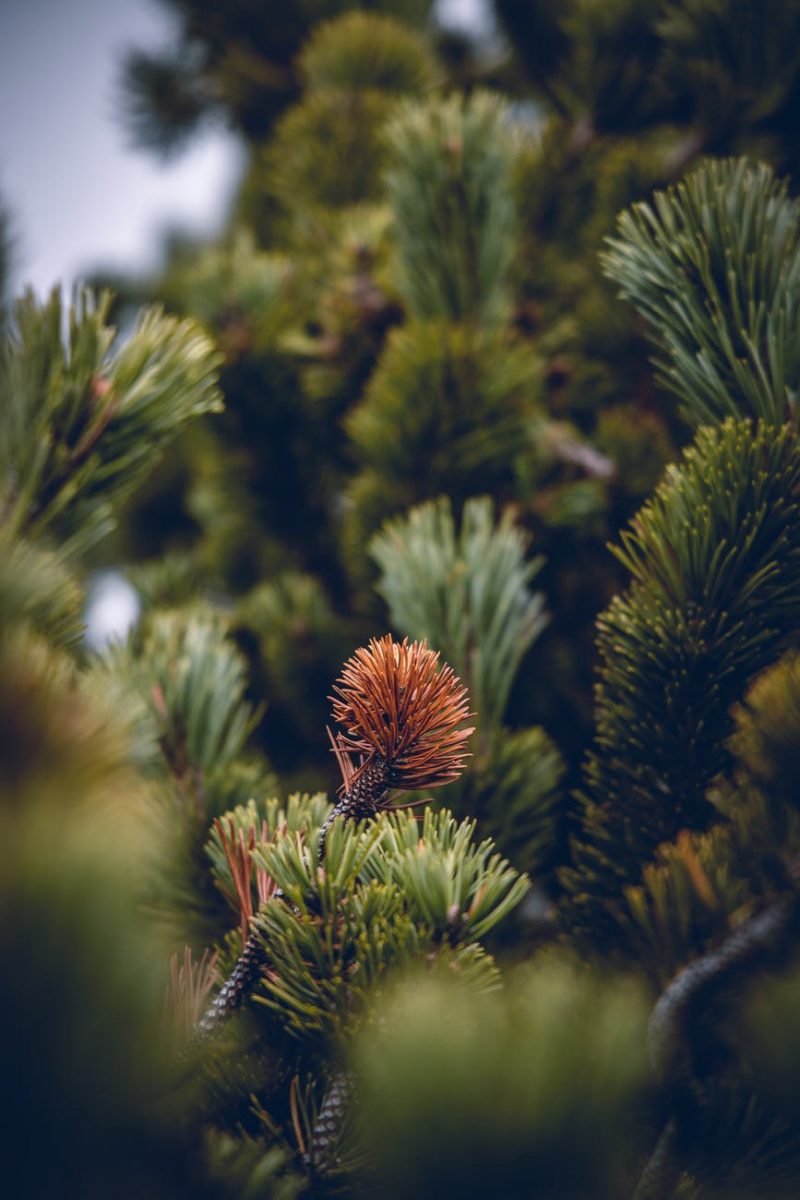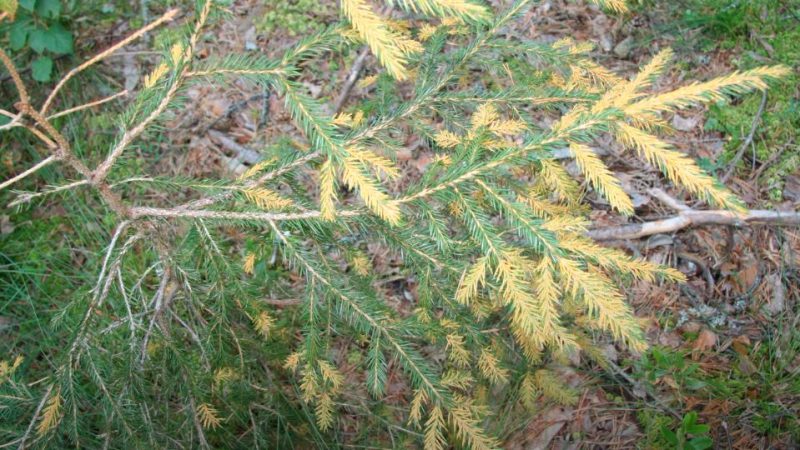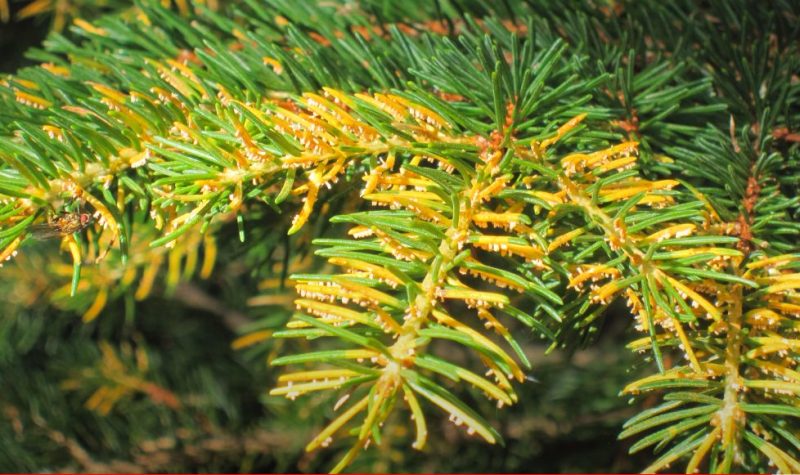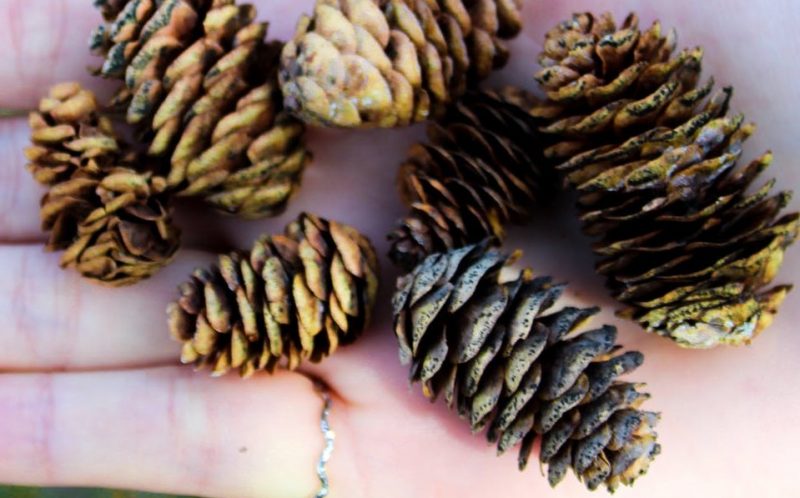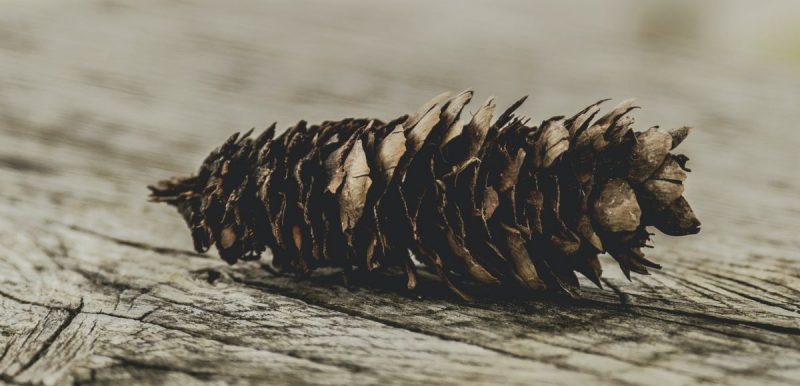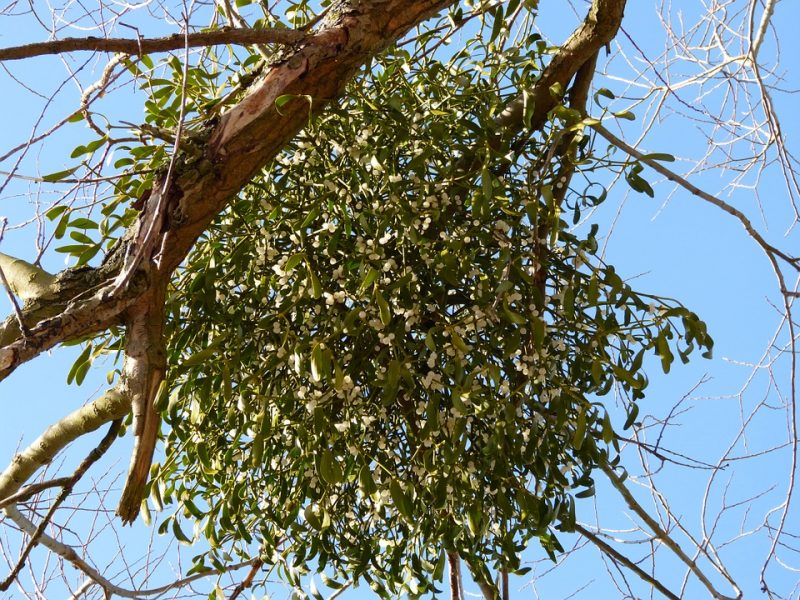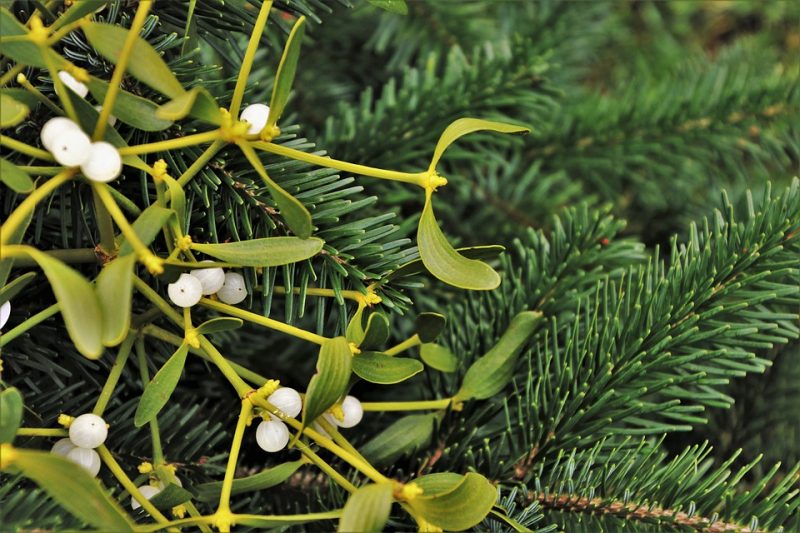Conifer diseases: affected needles, branches and cones
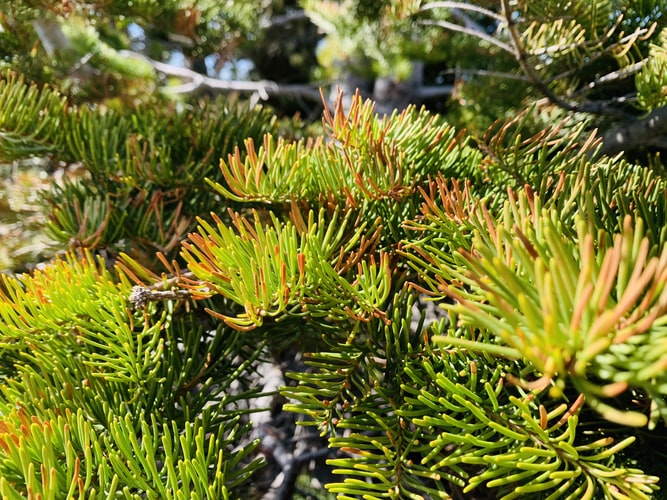
Most pathogens that cause damage to conifers thrive and spread under conditions of high temperatures and high soil and foliar moisture. Among the conifer diseases affecting needles, branches, and fruit, the most common are:
1. Stem canker of larch (Lachnellula willkommii)
Most frequently, the 4-5-year-old larch saplings and the 10-25-year-old larch trees are affected by such conifer diseases. Stagnant water in the soil or excessive moisture favors the spread of pathogens.
Host plants. Larch;
Lachnellula species can infect other conifer species:
- L. calycina – pine and spruce;
- L. pini – pine;
- L. fuscosanguinea – pine;
- L. flavovirens – pine and juniper;
- L. subtilissima – fir, less frequently spruce and pine.
Symptoms. The fungi colonize trees through wounds or cracks on shoots younger than 4 years. In the affected area, smooth, dull spots can be seen, with uneven edges (like waves). In time, the spots increase in size, and the bark cracks and peels off. In the case of low vigour trees, the affected shoots dry quickly. Wilting, drying and needle drop starts at the crown tip and progresses towards the base of the crown, and from the top of the branches towards the inside part of the crown. Orange fruit bodies can be observed on the affected trees in all months of the year.
Prevention and control methods:
- avoid planting larch trees in areas with excess moisture;
- the planting material should be purchased from authorised nurseries, located near the planting site;
- respecting the recommended planting distances between trees;
- rapid removal of broken, damaged or infested trees;
- artificial pruning of trees.
2. Shoot blights and diebacks (Sirococcus strobilinus, Phomopsis sp., Thekopsora areolata, Ascocalyx abietina, Sphaeropsis sapinea, Botrytis cinerea)
Pathogens contribute to needle and shoot drying, thus thinning the crown. Following a severe attack, the tree may dry out completely.
Host plants.
- Sirococcus strobilinus on spruce seedlings;
- Thekopsora areolata on spruce or pine seedlings (later on Prunus species); it can also infest cones;
- Phomopsis sp. on seedlings of several conifer species;
- Ascocalyx abietina on pine, Swiss pine, spruce;
- Sphaeropsis sapinea on pine;
- Botrytis cinerea on Douglas fir seedlings, less frequently on other coniferous species.
Symptoms. The pathogens attack the shoots and branches, causing reddening, wilting, and needle drop. In the end, the shoots dry out. The growth in diameter and height is reduced, trees are weakened or even completely dried out in case of strong and long-lasting attacks.
- In the case of Sirococcus strobilinus, the needles from the middle or basal part of the shoots fall first. The shoots curve. The first signs of the infection can be observed in spring;
- In the case of Thekopsora areolata, dark spots appear on the shoots in autumn, after which the shoots are curved and dry out. Yellowish or reddish spots can be seen on the infested Prunus species (often bird cherry);
- In the case of Ascocalyx abietina, needle drying starts in winter, from the base of the crown to the tip, respectively from the base of the branches to the tip. In spring the needles fall off and the shoot remains empty. The fruiting bodies of the fungus are dark in colour, very small in size and appear on the infested portions of the trees;
- In the case of Sphaeropsis sapinea, short, not fully developed needles can be observed. The dry needles remain in the crown of the tree;
- In the case of Botrytis cinerea, after wilting of the needles and bending of the shoots, a whitish or greyish felt can be observed on the affected portions. The conifer diseases can progress, affecting the branches and sometimes even the stem. Sometimes the seedlings die after the attack. The disease progresses from the tip of the needles to their base, from the tip of the branches to their base, and from the tip of the seedling to its base.
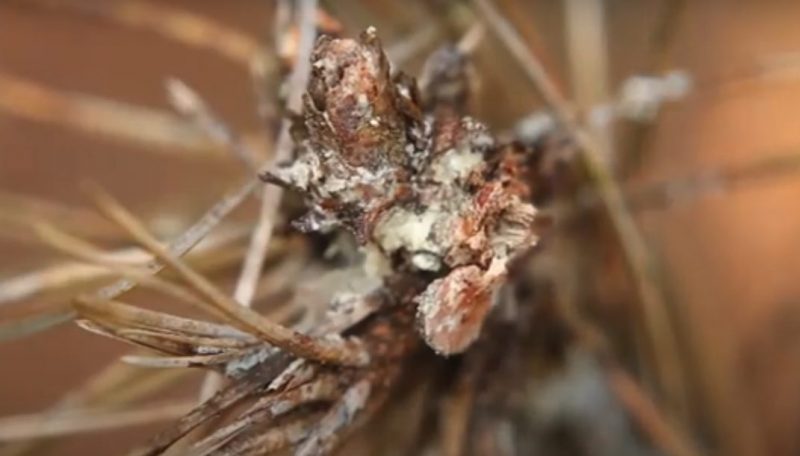
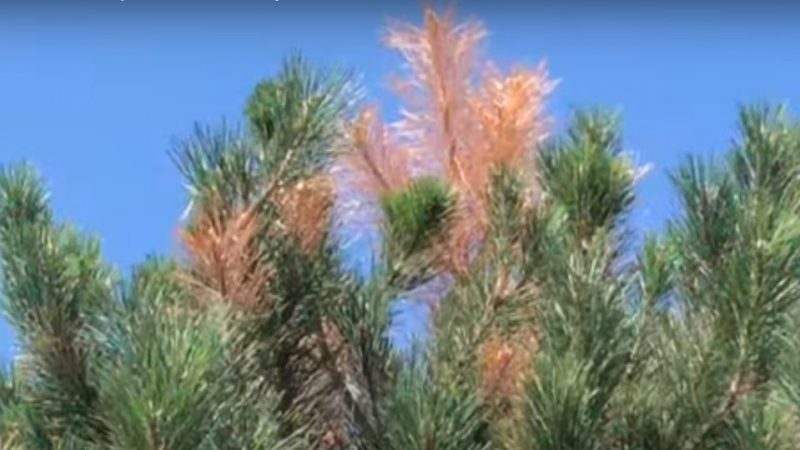
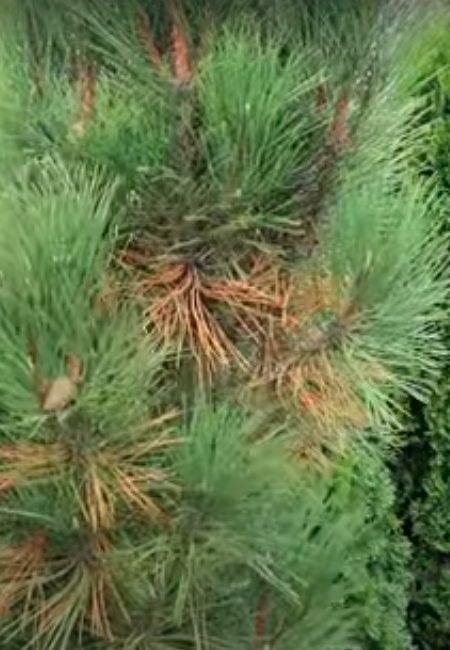
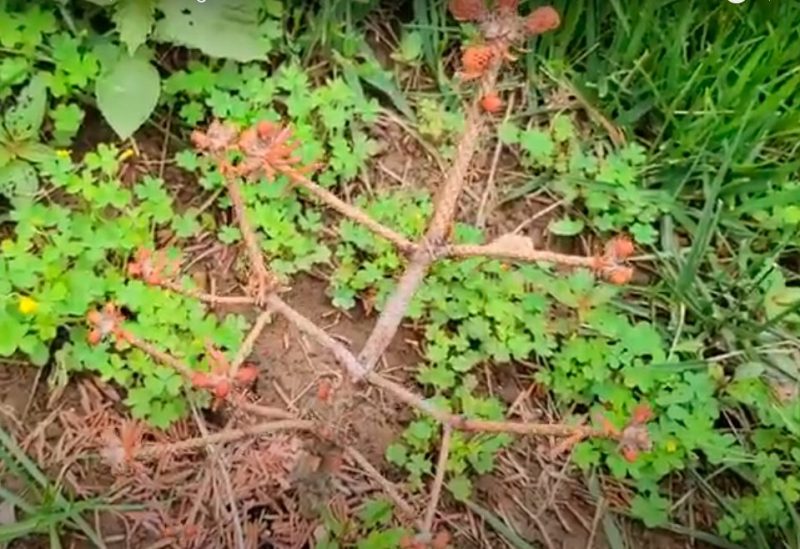
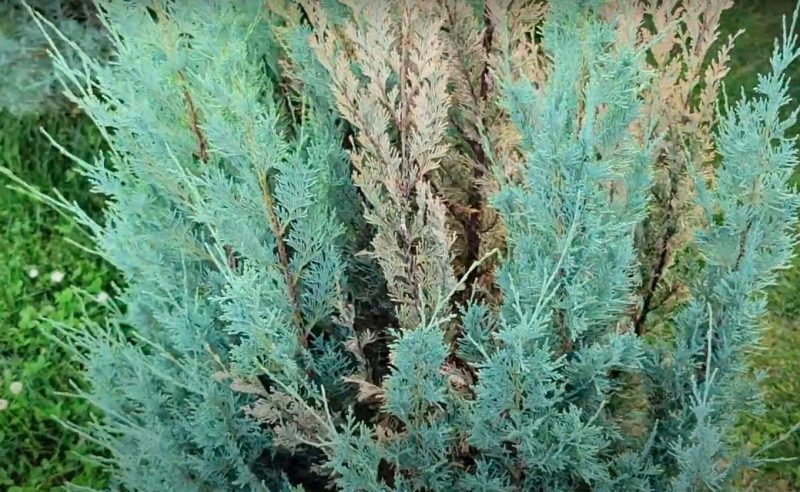
Prevention and control methods:
- maintaining good tree health;
- removal of speared, broken, fallen, or infested trees;
- removal of dry branches (as far as possible);
- ventilation of solariums;
- preventive treatments in spring;
- chemical treatments at the first signs of attack, with systemic fungicides;
- chemical treatments during the growing season, with contact fungicides.
Recommended products
-
You can find products on a different store
Change Store -
You can find products on a different store
Change Store -
You can find products on a different store
Change Store -
You can find products on a different store
Change Store -
You can find products on a different store
Change Store -
You can find products on a different store
Change Store -
You can find products on a different store
Change Store -
You can find products on a different store
Change Store -
You can find products on a different store
Change Store -
You can find products on a different store
Change Store -
You can find products on a different store
Change Store -
You can find products on a different store
Change Store -
You can find products on a different store
Change Store -
You can find products on a different store
Change Store -
You can find products on a different store
Change Store -
You can find products on a different store
Change Store -
You can find products on a different store
Change Store -
You can find products on a different store
Change Store -
You can find products on a different store
Change Store -
You can find products on a different store
Change Store -
You can find products on a different store
Change Store -
You can find products on a different store
Change Store -
You can find products on a different store
Change Store -
You can find products on a different store
Change Store
Recommended products
-
You can find products on a different store
Change Store -
You can find products on a different store
Change Store -
You can find products on a different store
Change Store -
You can find products on a different store
Change Store -
You can find products on a different store
Change Store -
You can find products on a different store
Change Store -
You can find products on a different store
Change Store -
You can find products on a different store
Change Store -
You can find products on a different store
Change Store -
You can find products on a different store
Change Store -
You can find products on a different store
Change Store -
You can find products on a different store
Change Store -
You can find products on a different store
Change Store -
You can find products on a different store
Change Store -
You can find products on a different store
Change Store -
You can find products on a different store
Change Store -
You can find products on a different store
Change Store -
You can find products on a different store
Change Store -
You can find products on a different store
Change Store -
You can find products on a different store
Change Store -
You can find products on a different store
Change Store -
You can find products on a different store
Change Store -
You can find products on a different store
Change Store -
You can find products on a different store
Change Store
3. Fir broom rust – conifer diseases (Melampsorella caryophyllacearum)
This rust fungus is commonly found in pure fir stands or mixed stands, especially in the older ones. Conifer diseases such as cerous swellings (tumors) caused by this species manage to reduce the economic value of the wood, facilitate the establishment of other pests or pathogens (especially rot), and predispose attacked trees to wind or snow damage.
Host plants. Heteroecious species, on fir and plants of the family Caryophyllaceae.
Symptoms. The pathogens colonize the young shoots, causing the formation of clusters of short, discolored, needle-like shoots. Hence the name “broom or witches’ broom”. Over time, cancerous tumors form and grow from year to year on the affected area. In 15-20 years, the ‘brooms’ fall off and a cracked, uneven swelling remains on the trunk.
Prevention and control methods:
- promoting the mixed stands, especially conifers with beech;
- maintaining good tree health;
- maintaining optimal distance between trees;
- pruning and burning the branches with brooms (preferably in the cold season);
- removal of the infected trees.
4. Stem rust of pine (Cronartium sp.)
This disease is also known as the ‘blister rust of Scots pine’ or ‘resin canker of pine’. The disease has been reported in both seedlings and mature trees in forests, orchards, gardens, parks, or special crops. After the infection, trees become prone to felling and other pest attacks. In case of mass multiplication, pathogens can cause slow drying of branches or whole trees.
Host plants. Heteroecious species. Pine is the first host.
Symptoms. Pathogens colonize trees through young shoots, from where the disease slowly advances to needles, branches, and stems. The first signs of attack are seen after a few years when light-colored spots appear on the bark. Also, resin leaks and cancerous swellings can be seen on the trunk, increasing from year to year.
Prevention and control methods:
- disinfection of seeds before sowing.
- promoting mixed stands: pine and deciduous species;
- removal of the infested trees;
- clearcut of heavily infested stands;
- chemical treatments with specific fungicides.
Recommended products
-
You can find products on a different store
Change Store -
You can find products on a different store
Change Store -
You can find products on a different store
Change Store -
You can find products on a different store
Change Store -
You can find products on a different store
Change Store -
You can find products on a different store
Change Store -
You can find products on a different store
Change Store -
You can find products on a different store
Change Store -
You can find products on a different store
Change Store -
You can find products on a different store
Change Store -
You can find products on a different store
Change Store -
You can find products on a different store
Change Store -
You can find products on a different store
Change Store -
You can find products on a different store
Change Store -
You can find products on a different store
Change Store -
You can find products on a different store
Change Store -
You can find products on a different store
Change Store -
You can find products on a different store
Change Store -
You can find products on a different store
Change Store -
You can find products on a different store
Change Store -
You can find products on a different store
Change Store -
You can find products on a different store
Change Store -
You can find products on a different store
Change Store -
You can find products on a different store
Change Store
Recommended products
-
You can find products on a different store
Change Store -
You can find products on a different store
Change Store -
You can find products on a different store
Change Store -
You can find products on a different store
Change Store -
You can find products on a different store
Change Store -
You can find products on a different store
Change Store -
You can find products on a different store
Change Store -
You can find products on a different store
Change Store -
You can find products on a different store
Change Store -
You can find products on a different store
Change Store -
You can find products on a different store
Change Store -
You can find products on a different store
Change Store -
You can find products on a different store
Change Store -
You can find products on a different store
Change Store -
You can find products on a different store
Change Store -
You can find products on a different store
Change Store -
You can find products on a different store
Change Store -
You can find products on a different store
Change Store -
You can find products on a different store
Change Store -
You can find products on a different store
Change Store -
You can find products on a different store
Change Store -
You can find products on a different store
Change Store -
You can find products on a different store
Change Store -
You can find products on a different store
Change Store
5. Snow blight of conifers (Herpotrichia sp.)
This conifer disease is also known as ‘black snow mould of conifers’ or ‘brown felt blight of conifers’. The pathogens cause damage to seedlings and mature trees, especially in mountainous, subalpine, and alpine areas.
Host plants. Conifers. Herpotrichia parasitica is specific to fir, and Herpotrichia juniperi to juniper.
Symptoms. Following the infection, the young shoots are covered with a dark felt. The seedlings can be completely covered and can dry out. In the case of mature trees, the disease is observed especially on the branches at the base of the crown. Very small, black, globular spots appear on the needles and bark.
Prevention and control methods:
- shaking off the snow from the seedlings in nurseries;
- stimulating the growth and development of seedlings;
- removing and burning the infested branches;
- applying copper-based treatments in the nurseries.
Recommended products
-
You can find products on a different store
Change Store -
You can find products on a different store
Change Store -
You can find products on a different store
Change Store -
You can find products on a different store
Change Store -
You can find products on a different store
Change Store -
You can find products on a different store
Change Store -
You can find products on a different store
Change Store -
You can find products on a different store
Change Store -
You can find products on a different store
Change Store -
You can find products on a different store
Change Store -
You can find products on a different store
Change Store -
You can find products on a different store
Change Store -
You can find products on a different store
Change Store -
You can find products on a different store
Change Store -
You can find products on a different store
Change Store -
You can find products on a different store
Change Store -
You can find products on a different store
Change Store -
You can find products on a different store
Change Store -
You can find products on a different store
Change Store -
You can find products on a different store
Change Store -
You can find products on a different store
Change Store -
You can find products on a different store
Change Store -
You can find products on a different store
Change Store -
You can find products on a different store
Change Store
6. Necrosis (Seimatosporium berckmansii, Cercospora sequoiae)
These conifer diseases affect especially the branches and the needles. Cercospora sequoiae is also known as the ‘needle blight of conifers’. Both are common diseases, especially in parks and gardens.
Host plants. Arborvitae, cypress, juniper, less often other coniferous species.
Symptoms.
- Seimatosporium berckmansii causes necrosis of branches from outside to inside; The infection first sets in on the young branches, then spreads to the older ones. The color of the tips of the branches changes from light green to reddish-brown.
- Cercospora sequoiae causes necrosis of branches from inside towards outside. Plant drought starts from the base of the trunk and advances to the top. The disease settles on the older branches and then advances to the younger ones. The affected needles turn yellow, then brown and fall to the ground.
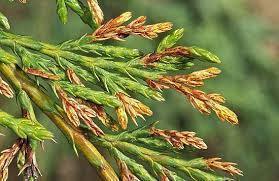
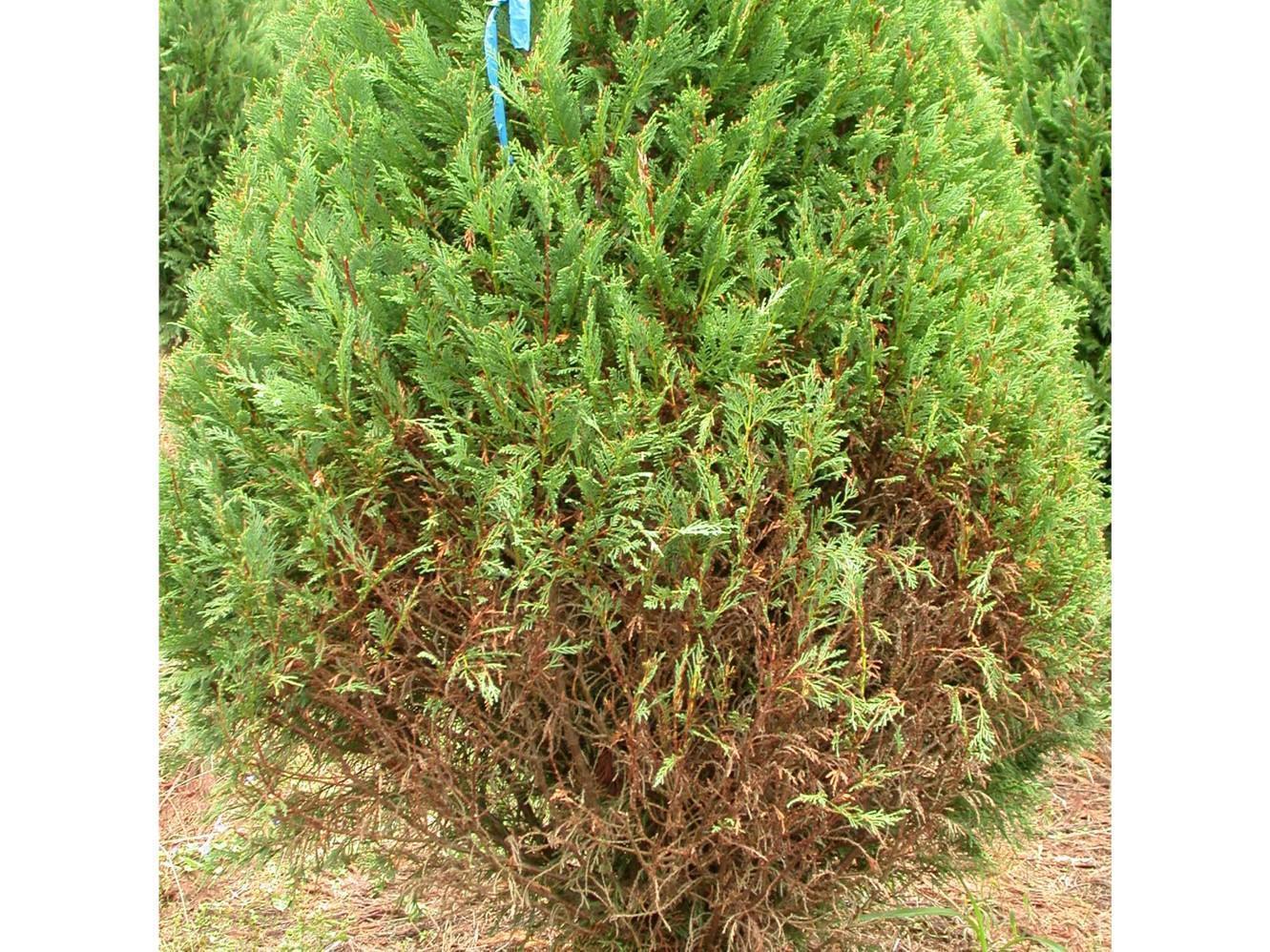
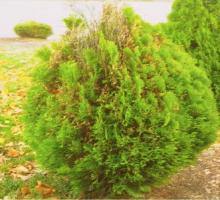
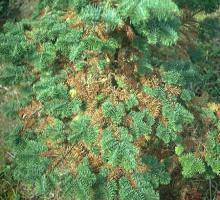
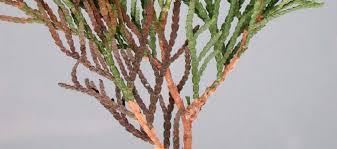
Prevention and control methods:
- periodic inspection of plant health condition;
- removal and burning of dry branches;
- performing treatments with specific fungicides.
Recommended products
-
You can find products on a different store
Change Store -
You can find products on a different store
Change Store -
You can find products on a different store
Change Store -
You can find products on a different store
Change Store -
You can find products on a different store
Change Store -
You can find products on a different store
Change Store -
You can find products on a different store
Change Store -
You can find products on a different store
Change Store -
You can find products on a different store
Change Store -
You can find products on a different store
Change Store -
You can find products on a different store
Change Store -
You can find products on a different store
Change Store -
You can find products on a different store
Change Store -
You can find products on a different store
Change Store -
You can find products on a different store
Change Store -
You can find products on a different store
Change Store -
You can find products on a different store
Change Store -
You can find products on a different store
Change Store -
You can find products on a different store
Change Store -
You can find products on a different store
Change Store -
You can find products on a different store
Change Store -
You can find products on a different store
Change Store -
You can find products on a different store
Change Store -
You can find products on a different store
Change Store
Recommended products
-
You can find products on a different store
Change Store -
You can find products on a different store
Change Store -
You can find products on a different store
Change Store -
You can find products on a different store
Change Store -
You can find products on a different store
Change Store -
You can find products on a different store
Change Store -
You can find products on a different store
Change Store -
You can find products on a different store
Change Store -
You can find products on a different store
Change Store -
You can find products on a different store
Change Store -
You can find products on a different store
Change Store -
You can find products on a different store
Change Store -
You can find products on a different store
Change Store -
You can find products on a different store
Change Store -
You can find products on a different store
Change Store -
You can find products on a different store
Change Store -
You can find products on a different store
Change Store -
You can find products on a different store
Change Store -
You can find products on a different store
Change Store -
You can find products on a different store
Change Store -
You can find products on a different store
Change Store -
You can find products on a different store
Change Store -
You can find products on a different store
Change Store -
You can find products on a different store
Change Store
7. Needle blight of thuja (Kabatina Thujae)
Trees and shrubs can dry out completely after the attack of conifer diseases.
Host plants. Juniper, arborvitae, cypress.
Symptoms. In spring or even before entering the vegetation, the affected tissue turns yellow, then turns red and brown, and falls off the plant. Black spots appear on the affected tissue, representing the fructification of the fungus.
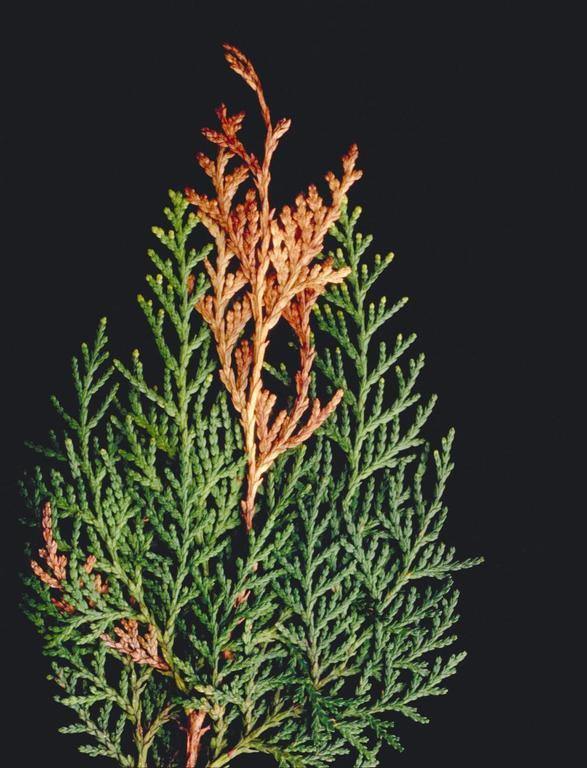
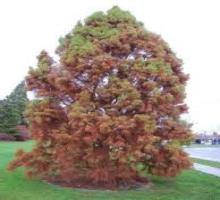
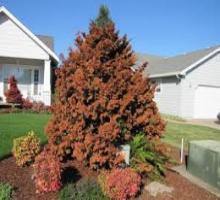
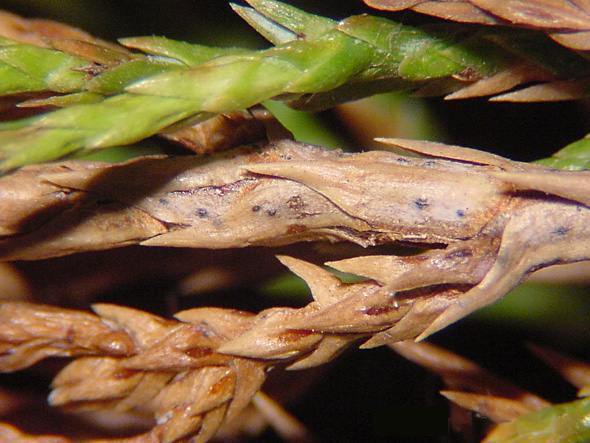
Prevention and control methods:
- avoiding pruning interventions in wet weather and thus creating areas, wounds where pathogens can enter;
- avoid sprinkler irrigation, excessive and irregular watering. Irrigation is preferably done in the morning. Irrigation in the evening, correlated with the lower temperatures of cold nights, favors the development and spread of pathogens;
- performing treatments with specific products.
Recommended products
-
You can find products on a different store
Change Store -
You can find products on a different store
Change Store -
You can find products on a different store
Change Store -
You can find products on a different store
Change Store -
You can find products on a different store
Change Store -
You can find products on a different store
Change Store -
You can find products on a different store
Change Store -
You can find products on a different store
Change Store -
You can find products on a different store
Change Store -
You can find products on a different store
Change Store -
You can find products on a different store
Change Store -
You can find products on a different store
Change Store -
You can find products on a different store
Change Store -
You can find products on a different store
Change Store -
You can find products on a different store
Change Store -
You can find products on a different store
Change Store -
You can find products on a different store
Change Store -
You can find products on a different store
Change Store -
You can find products on a different store
Change Store -
You can find products on a different store
Change Store -
You can find products on a different store
Change Store -
You can find products on a different store
Change Store -
You can find products on a different store
Change Store -
You can find products on a different store
Change Store
Recommended products
-
You can find products on a different store
Change Store -
You can find products on a different store
Change Store -
You can find products on a different store
Change Store -
You can find products on a different store
Change Store -
You can find products on a different store
Change Store -
You can find products on a different store
Change Store -
You can find products on a different store
Change Store -
You can find products on a different store
Change Store -
You can find products on a different store
Change Store -
You can find products on a different store
Change Store -
You can find products on a different store
Change Store -
You can find products on a different store
Change Store -
You can find products on a different store
Change Store -
You can find products on a different store
Change Store -
You can find products on a different store
Change Store -
You can find products on a different store
Change Store -
You can find products on a different store
Change Store -
You can find products on a different store
Change Store -
You can find products on a different store
Change Store -
You can find products on a different store
Change Store -
You can find products on a different store
Change Store -
You can find products on a different store
Change Store -
You can find products on a different store
Change Store -
You can find products on a different store
Change Store
8. Needle blight diseases (Lophodermium sp., Hypodermella sp., Naemacyclus sp., Melanconium sp., Dothistroma septospora)
Pathogens can cause the loss of needles and thus reduce the vigor of seedlings and trees.
Host plants. Coniferous species, especially pines:
- Lophodermium sp. – pine, juniper, fir, spruce;
- Hypodermella sp. – pine, rarely larch;
- Naemacyclus sp. – pine;
- Melanconium sp. – bog pine, Scots pine;
- Dothistroma septospora – pine, rarely larch and Douglas fir.
Symptoms.
- Lophodermium sp. The attack can be seen in autumn, when small yellow or purple spots appear on the needles. These enlarge over time and turn brown, at the edges being sometimes delimited with a black outline from the unaffected portions. Over time the affected needles turn red, sometimes falling late, even after two years;
- Hypodermella sp. The discoloration of some portions of the needles can be observed. The base of the needles often remains green, delimited from the affected area by a stripe. Before falling, the needles have a whitish color.
- Naemacyclus sp. Yellow portions can be seen on the needles in autumn, and discoloration takes place in winter. Small, reddish spots appear before the needles fall.
- Melanconium species cause infections on the young needles in late spring and early summer. The needles turn red from their top to the bottom;
- Dothistroma septospora. Reddish circular stripes are formed on the needles. Next year, emergent black lines or spots appear close to the stripes. The conifer diseases progress from the base of the crown to the top, respectively from the inside of the crown to the outside.
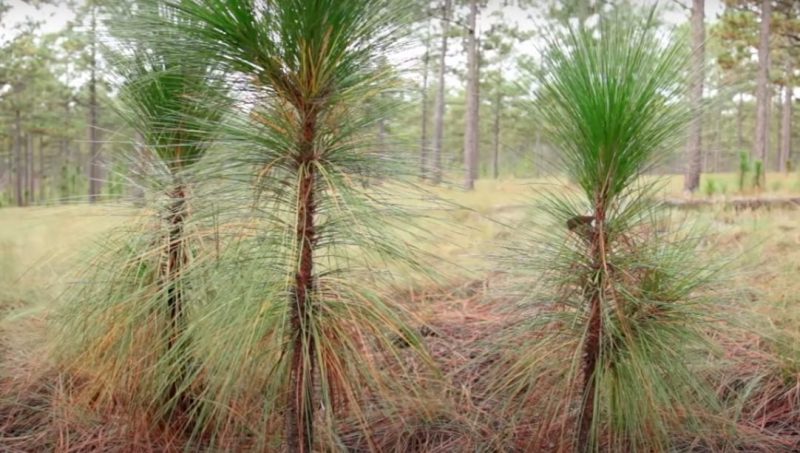
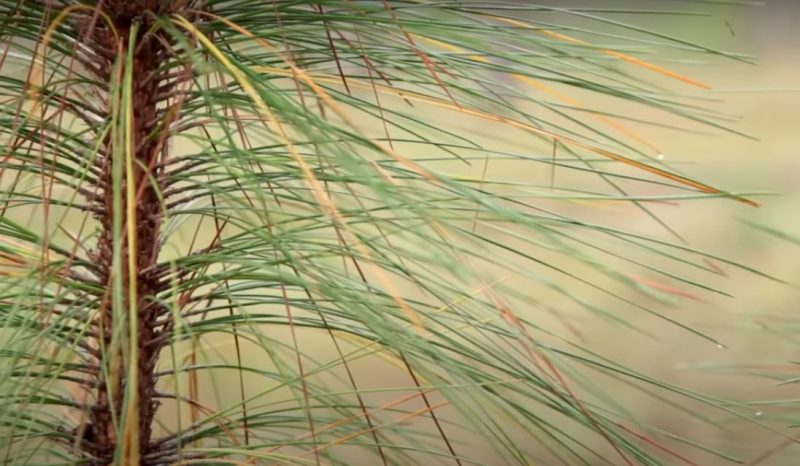
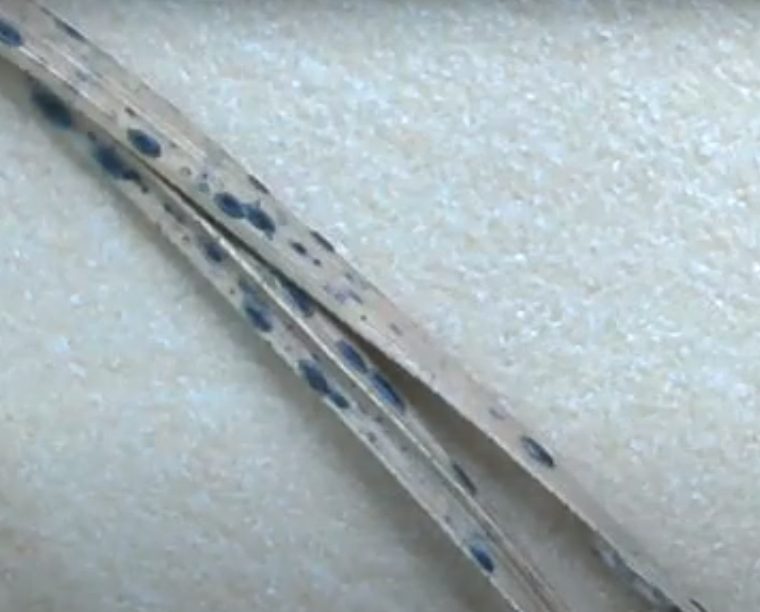
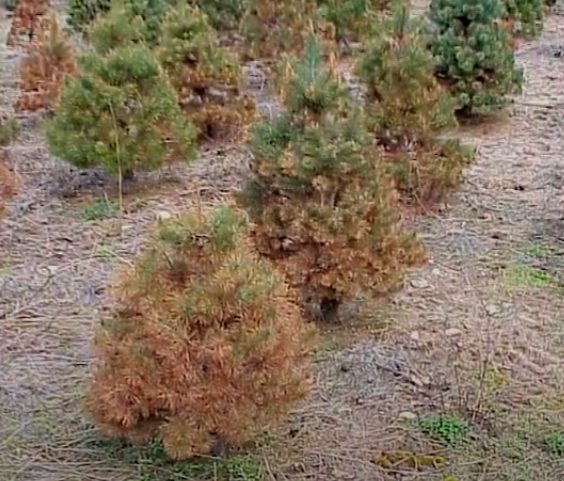
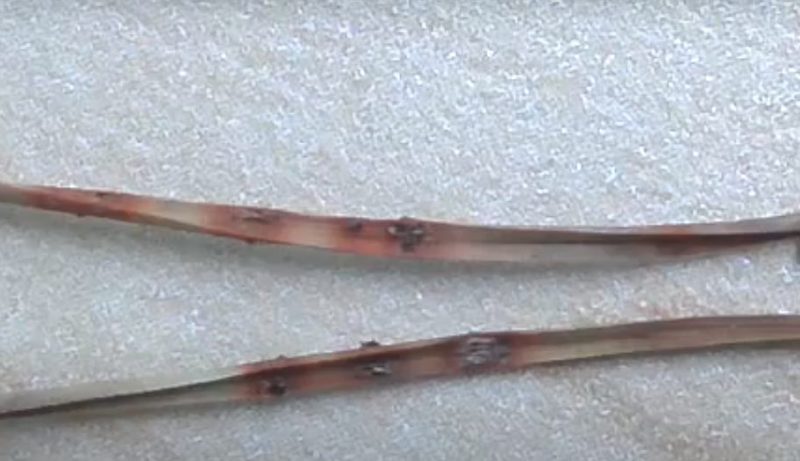
Prevention and control methods:
- maintaining the good health condition of the trees;
- ensuring an optimal distance between saplings and between trees;
- ensuring air circulation/ventilation in solariums and nurseries;
- removal of infected branches;
- avoiding excess moisture in the soil – in nurseries;
- treatments with systemic or contact fungicides in nurseries and young plantations.
Recommended products
-
You can find products on a different store
Change Store -
You can find products on a different store
Change Store -
You can find products on a different store
Change Store -
You can find products on a different store
Change Store -
You can find products on a different store
Change Store -
You can find products on a different store
Change Store -
You can find products on a different store
Change Store -
You can find products on a different store
Change Store -
You can find products on a different store
Change Store -
You can find products on a different store
Change Store -
You can find products on a different store
Change Store -
You can find products on a different store
Change Store -
You can find products on a different store
Change Store -
You can find products on a different store
Change Store -
You can find products on a different store
Change Store -
You can find products on a different store
Change Store -
You can find products on a different store
Change Store -
You can find products on a different store
Change Store -
You can find products on a different store
Change Store -
You can find products on a different store
Change Store -
You can find products on a different store
Change Store -
You can find products on a different store
Change Store -
You can find products on a different store
Change Store -
You can find products on a different store
Change Store
Recommended products
-
You can find products on a different store
Change Store -
You can find products on a different store
Change Store -
You can find products on a different store
Change Store -
You can find products on a different store
Change Store -
You can find products on a different store
Change Store -
You can find products on a different store
Change Store -
You can find products on a different store
Change Store -
You can find products on a different store
Change Store -
You can find products on a different store
Change Store -
You can find products on a different store
Change Store -
You can find products on a different store
Change Store -
You can find products on a different store
Change Store -
You can find products on a different store
Change Store -
You can find products on a different store
Change Store -
You can find products on a different store
Change Store -
You can find products on a different store
Change Store -
You can find products on a different store
Change Store -
You can find products on a different store
Change Store -
You can find products on a different store
Change Store -
You can find products on a different store
Change Store -
You can find products on a different store
Change Store -
You can find products on a different store
Change Store -
You can find products on a different store
Change Store -
You can find products on a different store
Change Store
9. Needle rust diseases (Coleosporium sp., Chrysomyxa sp., Pucciniastrum sp.)
These fungi parasitize the needles of both mature and young trees. These conifer diseases can cause defoliation of the affected shoots. In the case of seedlings, even permanent drying can occur.
Host plants. Heteroecious species. Conifers (pine, spruce, fir) are the first hosts and other plant species are the second hosts (cranberry, mountain peony, blueberry, grass species, etc.).
Symptoms.
- Coleosporium sp. Light spots appear on the needles, which eventually turn brown. Yellow-orange blisters appear on these spots, with a white topside .
- Chrysomyxa rhododendri. Yellow stripes appear, with blisters on both sides of the needles.
- Chrysomyxa abietis. Delimited yellow stripes appear on the needles in spring. In autumn, some orange or rust-coloured swellings appear.
- Pucciniastrum epilobii. Small, yellow spots appear on the lower face of the fir needles. Next to these points, elongated, white tubes (bliesters) appear, arranged in two rows along the needles.
Prevention and control methods:
- removal of plant species that serve as second hosts;
- creation of mixed stands: conifers and deciduous species;
- application of chemical treatments with specific fungicides.
Recommended products
-
You can find products on a different store
Change Store -
You can find products on a different store
Change Store -
You can find products on a different store
Change Store -
You can find products on a different store
Change Store -
You can find products on a different store
Change Store -
You can find products on a different store
Change Store -
You can find products on a different store
Change Store -
You can find products on a different store
Change Store -
You can find products on a different store
Change Store -
You can find products on a different store
Change Store -
You can find products on a different store
Change Store -
You can find products on a different store
Change Store -
You can find products on a different store
Change Store -
You can find products on a different store
Change Store -
You can find products on a different store
Change Store -
You can find products on a different store
Change Store -
You can find products on a different store
Change Store -
You can find products on a different store
Change Store -
You can find products on a different store
Change Store -
You can find products on a different store
Change Store -
You can find products on a different store
Change Store -
You can find products on a different store
Change Store -
You can find products on a different store
Change Store -
You can find products on a different store
Change Store
Recommended products
-
You can find products on a different store
Change Store -
You can find products on a different store
Change Store -
You can find products on a different store
Change Store -
You can find products on a different store
Change Store -
You can find products on a different store
Change Store -
You can find products on a different store
Change Store -
You can find products on a different store
Change Store -
You can find products on a different store
Change Store -
You can find products on a different store
Change Store -
You can find products on a different store
Change Store -
You can find products on a different store
Change Store -
You can find products on a different store
Change Store -
You can find products on a different store
Change Store -
You can find products on a different store
Change Store -
You can find products on a different store
Change Store -
You can find products on a different store
Change Store -
You can find products on a different store
Change Store -
You can find products on a different store
Change Store -
You can find products on a different store
Change Store -
You can find products on a different store
Change Store -
You can find products on a different store
Change Store -
You can find products on a different store
Change Store -
You can find products on a different store
Change Store -
You can find products on a different store
Change Store
10. Cone diseases (Thekopsora areolata, Sphaeropsis sapinea, Phomopsis conorum)
After conifer diseases infestations, the seeds may remain undeveloped, become sterile or be fertile. Through the latter, the disease can be transmitted to the next generation through sowing or natural regeneration.
Host plants.
- Thekopsora areolata on spruce and Prunus species;
- Sphaeropsis sapinea on pine;
- Phomopsis conorum on conifers.
Symptoms.
- Thekospora areolata. Deformation and twisting of scales, premature fall of cones;
- Shaeropsis sapinea. It infects pine branches, then passes on the cones, sometimes blocking their development. Small black dots can be seen on the affected cones.
- Phomopsis conorum. It infects the needles and causes drying of the branches, after which the cones are also infected.
Prevention and control methods:
- gathering and destroying infected or prematurely fallen cones;
- checking the seeds before sowing (by surveys);
- treating the seeds with specific fungicides before sowing.
Recommended products
-
You can find products on a different store
Change Store -
You can find products on a different store
Change Store -
You can find products on a different store
Change Store -
You can find products on a different store
Change Store -
You can find products on a different store
Change Store -
You can find products on a different store
Change Store -
You can find products on a different store
Change Store -
You can find products on a different store
Change Store -
You can find products on a different store
Change Store -
You can find products on a different store
Change Store -
You can find products on a different store
Change Store -
You can find products on a different store
Change Store -
You can find products on a different store
Change Store -
You can find products on a different store
Change Store -
You can find products on a different store
Change Store -
You can find products on a different store
Change Store -
You can find products on a different store
Change Store -
You can find products on a different store
Change Store -
You can find products on a different store
Change Store -
You can find products on a different store
Change Store -
You can find products on a different store
Change Store -
You can find products on a different store
Change Store -
You can find products on a different store
Change Store -
You can find products on a different store
Change Store
11. Common mistletoe infection (Viscum album)
A mistletoe is a hemiparasitic plant that multiplies through seeds, often transported by birds from one tree to another.
Host plants. Viscum album var. abietis on fir and spruce, Viscum album var. pini on pine.
Symptoms. After the germination of the seed, the plant attaches to the bark of the tree and forms sucker-like haustorium. Water and nutrients from the host plant are absorbed through haustorium. The mistletoe has a short stem, reaches a height of max. 80 cm and has evergreen leaves. The flowers are white, globular. Infected trees become weakened, and after the mistletoe has dried in the affected area, the phenomenon of “wet heart” appears (sap penetrates the wood through the holes of the haustorium).
Prevention and control methods:
- early removal of the hemiparasitic plant from the host plant.
Important:
- Conifer disease control treatments can be performed at any time of the year. At the time of application (and in the following hours) there should not be precipitations. Also, the temperatures should not be very high and there should be no danger of frost in the air.
- Drying symptoms can often occur shortly after planting. These can be caused by non-compliance with the planting period. Also, the purchased plants can present health issues right from the nursery. It is recommended to check the dendrological material before purchasing it.
- When purchasing seedlings, it is recommended to check the roots.
- Excessive watering of conifers prevents water drainage and air circulation to the roots, causing suffocation.
- If possible, the ground around the conifers will be kept clean, free of weeds and grass.
- Coniferous trees and shrubs prefer permeable soils, which allow good water drainage. If the planting is done in a compact soil, aeration work should be performed.
- For a successful planting, it is recommended to plant conifers in the seedling development stage.
- To reduce the stress caused by planting, it is recommended to apply biostimulators.
- Sprinkler irrigation system should be avoided in the case of conifers.














































































































































































































































































































































































































































